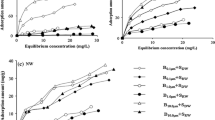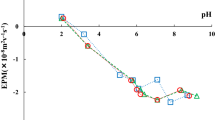Abstract
Biofilms were developed on glass microscope slides in a natural aquatic environment and their mercury adsorption properties were evaluated. Results demonstrated that the biofilms contained a large number of bacterial cells and associated extracellular polymers. Mercury forms detected in the biofilms were mainly bound to residual matter and organic acids. The adsorption processes could be described by a Langmuir isotherm. The optimum conditions for adsorption of mercury to natural biofilm were an ionic strength of 0.1 mol/L, pH 6 and an optimum adsorption time of 40 min. The transformation rate was 0.79 μg gaseous mercury per gram of biofilm.





Similar content being viewed by others
References
Cheng J, Yuan T, Yang L, Hu W, Zheng M, Wang W, Liu X, Qu L (2005) Neurobiological disruptions induced in brains of the rats fed with mercury contaminated rice collected from experimental fields in Guizhou Province, China. Chin Sci Bull 50:2441–2447. doi:10.1360/982005-229
Cheng J, Yuan T, Wang W, Jia J, Lin X, Qu L, Ding Z (2006) Mercury pollution in two typical areas in Guizhou province, China and its neurotoxic effects in the brains of rats fed with local polluted rice. Environ Geochem Health 28:499–507. doi:10.1007/s10653-005-7570-y
Coelho-Souza SA, Guimaraes JR, Mauro JB, Miranda MR, Azevedo SM (2006) Mercury methylation and bacterial activity associated to tropical phytoplankton. Sci Total Environ 364:188–199. doi:10.1016/j.scitotenv.2005.07.010
Dill C, Kuiken T, Zhang H, Ensor M (2006) Diurnal variation of dissolved gaseous mercury (DGM) levels in a southern reservoir lake (Tennessee, USA) in relation to solar radiation. Sci Total Environ 357:176–193. doi:10.1016/j.scitotenv.2005.04.011
Dong D, Li Y, Zhang B, Hua X, Yue B (2001) Selective chemical extraction and separation of Mn, Fe oxides and organic material in natural surface coatings: application to the study of trace metal adsorption mechanism in aquatic environments. Microchem J 69:89–94. doi:10.1016/S0026-265X(01)00068-6
Dong D, Hua X, Li Y, Li Z (2002) Lead adsorption to metal oxides and organic material of freshwater surface coatings determined using a novel selective extraction method. Environ Pollut 119:317–321. doi:10.1016/S0269-7491(02)00104-5
Dong D, Derry L, Lion L (2003) Pb scavenging from a freshwater lake by Mn oxides in heterogeneous surface coating materials. Water Res 37:1662–1666. doi:10.1016/S0043-1354(02)00556-0
Feng Q, Lin Q, Gong F, Sugita S, Shoya M (2004) Adsorption of lead and mercury by rice husk ash. J Colloid Interface Sci 278:1–8. doi:10.1016/j.jcis.2004.05.030
Jain CK, Ram D (1997) Adsorption of lead and zinc on bed sediments of the river Kali. Water Res 31:154–162. doi:10.1016/S0043-1354(96)00232-1
Jeon C, Park KH (2005) Adsorption and desorption characteristics of mercury(II) ions using aminated chitosan bead. Water Res 39:3938–3944. doi:10.1016/j.watres.2005.07.020
Krishnan KA, Anirudhan TS (2002) Removal of mercury(II) from aqueous solutions and chlor-alkali industry effluent by steam activated and sulphurised activated carbons prepared from bagasse pith: kinetics and equilibrium studies. J Hazard Mater 92:161–183. doi:10.1016/S0304-3894(02)00014-6
Liu G, Cabrera J, Allen M, Cai Y (2006) Mercury characterization in a soil sample collected nearby the DOE Oak ridge reservation utilizing sequential extraction and thermal desorption method. Sci Total Environ 369:384–392. doi:10.1016/j.scitotenv.2006.07.011
Loaec M, Olier R, Guezennec J (1997) Uptake of lead, cadmium and zinc by a novel bacterial exopolysaccharide. Water Res 31:1171–1179. doi:10.1016/S0043-1354(96)00375-2
Manohar DM, Krishnan KA, Anirudhan TS (2002) Removal of mercury(II) from aqueous solutions and chlor-alkali industry wastewater using 2-mercaptobenzimidazole-clay. Water Res 36:1609–1619. doi:10.1016/S0043-1354(01)00362-1
Renneberg AJ, Dudas MJ (2001) Transformations of elemental mercury to inorganic and organic forms in mercury and hydrocarbon co-contaminated soils. Chemosphere 45:1103–1109. doi:10.1016/S0045-6535(01)00122-9
Wang W, Huang Y, Liu J, Peng A (2002a) Effect of some environmental factors on mercury(II) reduction by suspended particulate matter-associated Kluvera cryocrescens biofilms in waterbodies. Water Environ Res 74:77–81. doi:10.2175/106143002X139767
Wang W, Wang W, Zhang X, Wang D (2002b) Adsorption of p-chlorophenol by biofilm components. Water Res 36:551–560. doi:10.1016/S0043-1354(01)00267-6
Wu XH, Sun DH, Zhuang ZX, Wang XR, Gong HF, Hong JX, Lee FSC (2002) Analysis and leaching characteristics of mercury and arsenic in Chinese medicinal material. Anal Chim Acta 453:311–323. doi:10.1016/S0003-2670(01)01442-8
Author information
Authors and Affiliations
Corresponding author
Rights and permissions
About this article
Cite this article
Cheng, J., Zhao, W., Liu, Y. et al. Adsorption Properties and Gaseous Mercury Transformation Rate of Natural Biofilm. Bull Environ Contam Toxicol 81, 516–520 (2008). https://doi.org/10.1007/s00128-008-9526-2
Received:
Accepted:
Published:
Issue Date:
DOI: https://doi.org/10.1007/s00128-008-9526-2




